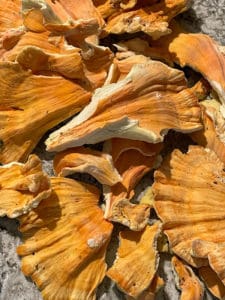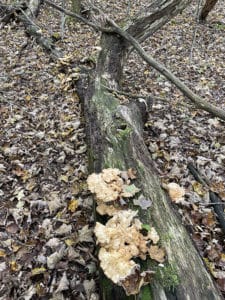By Brooke Geery
This time last year, Vermont was in a drought. The woods were in danger of catching on fire, and even did once or twice. As a newbie mushroom forager, I relished the challenge (and thrill) of finding good edibles. I had some success, and when I did, I gleefully gloated on social media and cooked my finds in as many ways as I locate on Google.

Chicken-of-the-woods blooms as a bright orange and yel- low. These fan-shaped mushrooms are generally about 2 to 10 inches (5-25 cm) in diameter with slightly curly edges.
This year, things are different. It’s been raining a lot and has been overall very warm, creating an ideal environment for many fungi to “flush” prolifically. It’s almost overwhelming, and after a May and June spent discovering lobsters, golden chanterelles, black trumpets, turkey tail and more with almost no effort, by midsummer I found myself a bit burnt out on finding, and more specifically, processing and eating mushrooms.
But as September, which happens to be the official “Mushroom Month” in America, came to a close, I once again found myself hiking through the woods and remembered how cool it is to walk in empty handed and leave with dinner. Late summer is the season for extra-meaty seasonal treats. This time of year is prime for a few varieties. Lion’s mane (Hericium erinaceus), which is spiny and white, can be found peeking out of nooks in walnut, beech, maple and birch trees and tastes like crab. Maitake, a.k.a. hen-of-the-woods (Grifola frondosa) grows at the base of the oldest oak trees. It has curvy brown layers that taste rich and earthy with a peppery finish, and can be prepared in place of beef in many recipes.
But the most prolific, and probably the easiest to find in west central Vermont, is chicken-of-the-woods (Laetiporus), which for the sake of saving ink I will refer to as COW. This bright orange and yellow mushroom, which grows on hardwood, particularly oak, is one of the easiest to identify and spot. Its blooms are large and flat with slightly curved edges that range from pinkish to deep burnt orange depending on the genus you find. The underside of each layer (it grows in a stacked formation) is light yellow with small pores. A keen eye can spot it from100 feet away, and it’s not uncommon to find an old oak log (either standing or fallen) that is flush with multiple blooms. One flush can yield several pounds of edible fruit. It’s also relatively long-lasting. Unlike some mushrooms that come and go in a day, chicken-of-the-woods will hang on for a while — depending on weather conditions — meaning you have more time to harvest (but you still have to beat the bugs or other foragers!).

As COW ages, it loses its color, turning into a crumbling white mess, still recognizable because of its form, but no longer useful. This was what I found first, covering a fallen oak stump on the top of a ridge in Clarendon. I poked at it, kicking myself for not being more motivated to get out there earlier. It was still beautiful though, so I took some pictures and made a mental note of the location and to be less lazy next season.
And then I turned around.
Less than 20 feet away, sprouting from a knot in a giant living oak, I saw COW in prime condition. The only problem — it was about 12 feet off the ground. Luckily, the tree was growing next to an old stone wall and on a hill, and using a sturdy stick, I was able to prod it down in pieces. My long-distance vision did not disappoint; this was perfect, tender and fresh fruit, with nary a bug hole or blemish. It held up well during its journey to the ground, and I was able to collect a couple pounds of decent-sized pieces. Of course, I hadn’t thought to bring a bag or a basket, so I loaded up both hands and carried my load home with my harvest pressed against my chest.
COW is, as implied by the name, a great chicken substitute. It cooks up nicely in “cutlet” or “finger” form, but I opted to tear mine into bite sized pieces and make nuggets. The fruit I found was thin and moist, and fried up nicely without any pre-cooking. The flavor is mild, and it really takes on whatever spices you cook it with. I kept it simple and am happy to report the following recipe was a hit with my tastebuds!
Beer battered chicken-of-the-woods nuggets
Ingredients:
- 1/2 cup corn starch
- 2 cups flour
- 2 teaspoons salt
- 1 teaspoon paprika
- 1 teaspoon garlic powder
- 1 tablespoon baking powder
- 1 12 oz beer (I used Switchback Ale)
Directions:
Prepare the mushrooms. Pat them down with a wet towel to remove any dirt or debris and discard any hard parts. It’s not recommended to run them under water or soak them to clean, as they will suck up excess moisture. Once all remnants of the tree are removed, tear them by hand into bite-sized pieces.
Prepare the batter. Mix the dry ingredients together, using a gallon resealable bag for ease and cleanliness. Next, pour in the beer, a little bit at a time, massaging the bag until it creates a thin batter.

Let your nuggets drain excess oil on a paper towel.
Combine the batter and mushrooms in a bowl, stirring to coat.
Heat about a 1/2 inch of vegetable oil in a skillet over medium heat until it’s not-quite-smoking. Dropping in a small bit of batter while the oil is heating is a sure-fire way to know when your oil is up to temp — when it starts to sizzle, you’re ready to fry!
Lower the heat slightly and cook the battered mushrooms in batches, being careful not to overcrowd the pan. Fry for about 5-6 minutes per side, shaking the pan gently to promote even frying. You may need to add more oil depending on how many batches you cook. Remove from the oil and drain on paper towels.
Dip in the sauce of your choice (such as a mix sriracha and ranch dressing) and enjoy!




